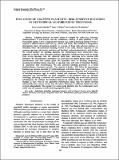Por favor, use este identificador para citar o enlazar a este item:
http://hdl.handle.net/10261/61895COMPARTIR / EXPORTAR:
 SHARE SHARE
 CORE
BASE CORE
BASE
|
|
| Visualizar otros formatos: MARC | Dublin Core | RDF | ORE | MODS | METS | DIDL | DATACITE | |

| Título: | Evolution of adaptive plasticity: Risk-sensitive hatching in neotropical leaf-breeding treefrogs |
Autor: | Gómez-Mestre, Iván CSIC ORCID; Wiens, John J.; Warkentin, K.M. | Fecha de publicación: | 2008 | Editor: | Ecological Society of America | Citación: | Ecological Monographs 78: 205- 224 (2008) | Resumen: | Adaptive plasticity at switch points in complex life cycles (e.g., hatching, metamorphosis) is well known, but the evolutionary history of such plasticity is not. Particularly unclear is how a single plastic response (e.g., shifts in hatching timing) evolves to respond to different threats and cues (e.g., abiotic and biotic). We conducted a comparative phylogenetic study of hatching plasticity in a group of frogs with arboreal embryos to determine when risk-accelerated hatching evolved in the clade, whether responses to two common egg-stage risks (snake predation and flooding) evolved independently, and whether the overall capacity for hatching plasticity was evolutionarily more conservative than responses to specific cues. Red-eyed treefrogs (Agalychnis callidryas) hatch early to escape from several egg-stage risks but otherwise hatch later, improving larval survival with predators. We reconstructed a phylogeny for Agalychnis and related genera based on three mitochondrial and four nuclear genes. We quantified onset of hatching competence, spontaneous hatching timing, responses to egg-stage risks, and costs of premature hatching in Agalychnis and Pachymedusa. We also assessed hatching plasticity in a basal phyllomedusine, Crttziohyla calcarifer. The capacity to hatch ∼30% before the spontaneous hatching age appears ancestral for phyllomedusines, with little change over ∼34-50 million years among the species examined. A strong hatching response to flooding, with no mortality of hatching-competent eggs, is similarly ancient and conserved. Premature hatchlings of Agalychnis and Pachymedusa are more vulnerable to fish predation than are full-term hatchlings, indicating a conserved risk trade-off across hatching that would make plasticity advantageous. In contrast, the hatching response to snake attack has undergone major changes at least twice in the Agalychnis-Pachymedusa clade, with two species showing substantially lower escape success than the others. Responses to different threats have thus evolved independently. The capacity for switch point plasticity may be evolutionarily more stable than the response to individual stage-specific threats. © 2008 by the Ecological Socity of America. | URI: | http://hdl.handle.net/10261/61895 | DOI: | 10.1890/07-0529.1 | Identificadores: | doi: 10.1890/07-0529.1 issn: 0012-9615 |
| Aparece en las colecciones: | (EBD) Artículos |
Ficheros en este ítem:
| Fichero | Descripción | Tamaño | Formato | |
|---|---|---|---|---|
| 07-0529.pdf | 389,98 kB | Adobe PDF |  Visualizar/Abrir |
CORE Recommender
SCOPUSTM
Citations
79
checked on 08-abr-2024
WEB OF SCIENCETM
Citations
78
checked on 23-feb-2024
Page view(s)
311
checked on 17-abr-2024
Download(s)
440
checked on 17-abr-2024
Google ScholarTM
Check
Altmetric
Altmetric
NOTA: Los ítems de Digital.CSIC están protegidos por copyright, con todos los derechos reservados, a menos que se indique lo contrario.
